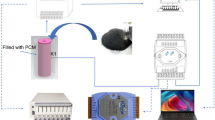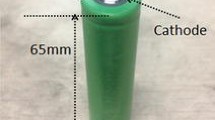Abstract
Since safety hazards may occur during the life of a Li-ion battery, it is important to learn the behavior under abuse conditions. In this paper, the variation of each characteristic parameter of the thermal runaway process for 32,650, NCM, and LiFePO4 square batteries are analyzed based on an overcharge experiment in Adiabatic Rate Calorimeter. NCM batteries at different charging rates and three kinds of single batteries at 1.00 C charging rate are tested for exploring the variation of thermal safety of lithium-ion batteries under overcharge conditions and getting the characterization of overcharge battery safety. Furthermore, a new index overcharge degree is introduced to evaluate the safety state of lithium batteries under different overcharge conditions given the comprehensive analysis of the variation trend of overcharged battery characteristic parameters, which provides ideas for the early safety warning of batteries at overcharging conditions. It is found that the initial runaway temperature of NCM battery decreases gradually with the increase of charging rate, but the initial runaway temperature of overcharge at 2.00 C is slightly lower than 1.50 C, the maximum runaway temperature of battery increases first and then decreases, the rate of voltage rise in the early stage increases with the increase of charging rate, the change rate of voltage and temperature of the battery increases as a whole, the voltage before thermal runaway decreases first and then increases, the total charging capacity shows a linear decline. In the 1.00 C overcharge experiments of the three batteries, the initial runaway temperature of 32,650 battery is the lowest, the maximum runaway temperature of square lithium iron phosphate battery is the highest, the temperature change rate of square lithium iron phosphate battery is the largest, the voltage of square lithium iron phosphate battery drops to 0 V first, and the overcharge time of NCM battery is the longest.






















Similar content being viewed by others
References
Kassem M, Delacourt C (2013) Postmortem analysis of calendar-aged graphite/LiFePO4 cells. J Power Sour 235:159–171. https://doi.org/10.1016/j.jpowsour.2013.01.147
Sanfelix J et al (2015) Environmental performance of advanced hybrid energy storage systems for electric vehicle applications. Appl Energy 137:925–930. https://doi.org/10.1016/j.apenergy.2014.07.012
Sasaki T, Ukyo Y, Novak P (2013) Memory effect in a lithium-ion battery. Nat Mater 12(6):569–575. https://doi.org/10.1038/nmat3623
Zhang J et al (2018) An overview on thermal safety issues of lithium-ion batteries for electric vehicle application. IEEE Access 6:23848–23863. https://doi.org/10.1109/ACCESS.2018.2824838
Liu Y-J, Guo H-J, Li X-H (2011) Al2O3 coating for improving thermal stability performance of manganese spinel battery. J Cent S Univ Technol 18(6):1844–1848
Zheng Y et al (2013) Cell state-of-charge inconsistency estimation for LiFePO4 battery pack in hybrid electric vehicles using mean-difference model. Appl Energy 111:571–580. https://doi.org/10.1016/j.apenergy.2013.05.048
Tobishima S, Yamaki J (1999) A consideration of lithium cell safety. J Power Sour 81:882–886. https://doi.org/10.1016/S0378-7753(98)00240-7
Saito Y, Takano K, Negishi A (2001) Thermal behaviors of lithium-ion cells during overcharge. J Power Sour 97–8:693–696. https://doi.org/10.1016/S0378-7753(01)00703-0
Ren D, Feng X, Lu L et al (2019) Overcharge behaviors and failure mechanism of lithium-ion batteries under different test conditions. J Appl Energy 250:323–332. https://doi.org/10.1016/j.apenergy.2019.05.015
Yuan QF, Zhao F, Wang W et al (2015) Overcharge failure investigation of lithium-ion batteries. J Electrochim Acta 178:682–688. https://doi.org/10.1016/j.electacta.2015.07.147
Leising RA, Palazzo MJ, Takeuchi ES et al (2001) A study of the overcharge reaction of lithium-ion batteries. J Power Sour 97–98:681–683. https://doi.org/10.1016/S0378-7753(01)00598-5
Finegan DP, Scheel M, James B et al (2016) Investigating lithium-ion battery materials during overcharge-induced thermal runaway: an operand and multi-scale X-ray CT study. J Phys Chem Chem Phys 18(45):30912–30919. https://doi.org/10.1039/c6cp04251a
Ren DS, Feng XN, Lu LG et al (2017) An electrochemical-thermal coupled overcharge-to-thermal-runaway model for lithium-ion battery. J Power Sour 364:328–340. https://doi.org/10.1016/j.jpowsour.2017.08.035
Qi C, Zhu YL, Gao F et al (2018) Mathematical model for thermal behavior of lithium-ion battery pack under overcharge. Int J Heat Mass Transfer 124:552–563. https://doi.org/10.1016/j.ijheatmasstransfer.2018.03.100
Lebkowski A (2017) Temperature, overcharge and short-circuit studies of batteries used in electric vehicles. J Przeglad Elektrotechniczny 1(5):67–73
Ji C, Sun J, Wang SH et al (2019) Experimental study on thermal safety of 32650 cell and battery module. J Beijing Univ Technol 45(08):780–786
Cabrera-Castillo E, Niedermeier F, Jossen A (2016) Calculation of the state of safety (SOS) for lithium-ion batteries. J Power Sour 324:509e520
Taniguchi S, Shironita S, Konakawa K et al (2019) Thermal characteristics of 80°C storage-degraded 18650-type lithium-ion secondary cells. J Power Sour 416(MAR 15):148–154. https://doi.org/10.1016/j.jpowsour.2019.01.087
Acknowledgements
This work was supported by the National Key R&D Program (Grant No. 2018YFB0105400) and Beijing Lab of New Energy Vehicles (Grant Nos. JF005015201901, JF005015201801). The authors also appreciate the teacher and all students in the group for their guidance and help with the experiment and simulation.
Author information
Authors and Affiliations
Corresponding author
Additional information
Publisher's Note
Springer Nature remains neutral with regard to jurisdictional claims in published maps and institutional affiliations.
Rights and permissions
About this article
Cite this article
Ji, C., Zhang, S., Wang, B. et al. Study on Thermal Safety of the Overcharged Lithium-Ion Battery. Fire Technol 59, 1089–1114 (2023). https://doi.org/10.1007/s10694-022-01256-9
Received:
Accepted:
Published:
Issue Date:
DOI: https://doi.org/10.1007/s10694-022-01256-9




